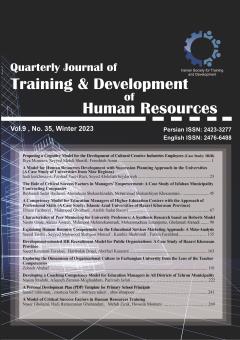-
-
List of Articles
-
Open Access Article
1 - Proposing a Cognitive Model for the Development of Creative Industries Employees (Case Study: IRIB )
Ilya Monzavi Mehdi Sharifi freshteh Amin -
Open Access Article
2 - Designing and presenting a model for human resource development with a succession approach in universities (Case study: Universities in Region 9 of the country)
hadi keikhosravi Farshad Faezi Razi Seyed Abdollah heydariyeh -
Open Access Article
3 - The Role of Critical Success Factors in Empowering Managers (Case Study: Isfahan Municipality Contracting Companies)
reihanehalsadat hashemi ahmadreza shekarchizadeh Mohammad shekarchian khouzestani -
Open Access Article
4 - Designing the competency model of training managers of higher education centers with a professional skills approach (Case study: Islamic Azad University, Mashhad Branch)
Atefe Razavi elham fariborzi Mahmood Ghorbani -
Open Access Article
5 - Features of peer mentoring program elements for university professors: Synthesis based on Roberts model
nasrin ozaei alireza assareh mahmood mehrmohamadi mohamadreza emamjomeh gholamali ahmadi -
Open Access Article
6 - Determining the competencies of Human Resource with the Approach of marketing educational services (a meta-Analysis literature review)
Saeed Talebi seyyed mahmoud shabgoo monsef Kambiz Shahroodi Farzin Farahbod -
Open Access Article
7 - Presenting a model for attracting human resources with a human resources development approach in government organizations (Case study: Khorasan Razavi province)
Saeed Keramati Tavalllaei habibolah doaei Abolfazl Kazemi -
Open Access Article
8 - Exploring the dimensions of organizational culture in Farhangian university From the lens of the teacher competencies
زهره عباباف -
Open Access Article
9 - Presenting a model for developing the coaching competencies of the education managers of the 22 districts of the mayor of Tehran
nasim madahi afsaneh zamani moghadam Parivash Jaafari -
Open Access Article
10 - Personal development plan (PDP) Model for primary school Managers
hamid rahimian morteza badri morteza taheri abas abaspoor -
Open Access Article
11 - Designing a model of critical success factors in human resource training
حیدریه naser gholami Hadi Ramezanian Fahndari Hossein momenimahmouei mehdi zirak
-
The rights to this website are owned by the Raimag Press Management System.
Copyright © 2017-2026







